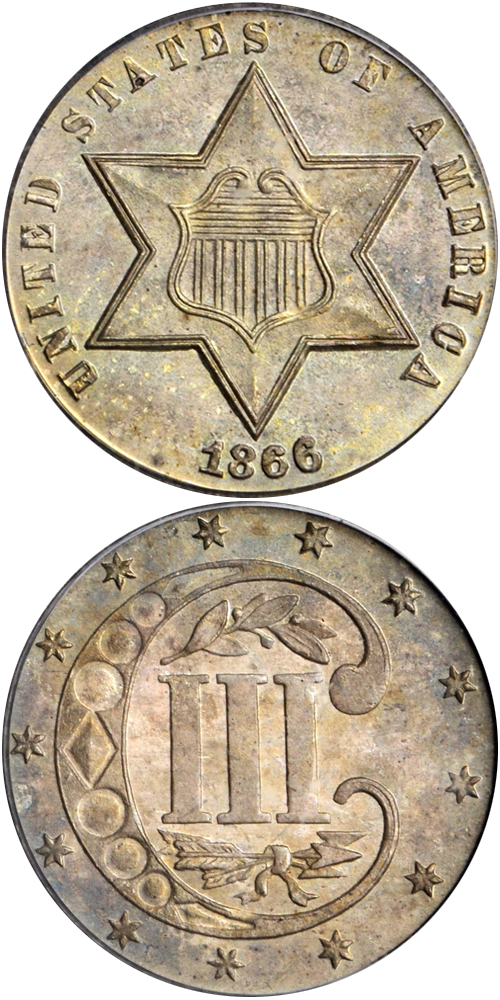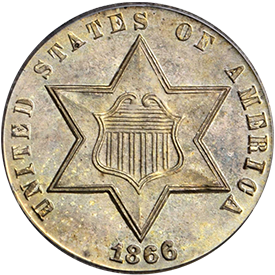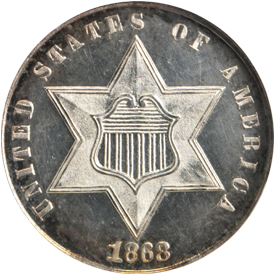Designed by: James Barton Longacre
Issue Dates: 1859-1873
Composition: 90% silver, 10% copper
Diameter: 14 mm
Weight: 0.75 grams (11.57 grains)
Edge: Plain
Business Strike Mintage: 1,572,600
Proof Mintage: 10,840
The silver three-cent piece was again modified in 1859. The three outlines to the obverse star were discontinued in favor of two outlines. At last, the problem of weak striking was solved, and from this point forward specimens were much more sharply struck than their predecessors. Still, occasional weak strikes persisted.
Examples were produced in large quantities for circulation from 1859 through 1862, after which time the hoarding of silver pieces during the Civil War made additional coinage redundant. After the war ended, in 1865, quantities produced remained small, for the coin was never popular with the public. Although several thousand business strikes are listed for each of various years from 1865 onward, today specimens encountered of these particular years are apt to be Proofs. Uncirculated examples of coins dated from 1866 through 1872 are extreme rarities. Most "Uncirculated" pieces seen by the writer have been Proofs. The last year, 1873, saw mintage only of Proofs, to the extent of an estimated 600 pieces.
The collector desiring an example for a type set will have no difficulty acquiring a specimen dated in the 1859 to 1862 range in grades from Fine through Extremely Fine or AU. Uncirculated pieces occur with some frequency, although truly superb examples are elusive. When they do occur, they are apt to be dated 1861 or 1862. Among higher grade pieces, most often seen are Proofs.
Further Reading
In 1859 the design was revised again. The Mint realized that pieces were not striking up properly, so the star outlines were changed from three to two, and other minor changes were made. While this did not completely end the problem, for dies spaced ever so slightly further apart than they should have been on certain issues still caused lightness of impression, most silver three-cent pieces of 1859 and later years are nevertheless quite sharp. Indeed, weakly struck pieces are the exception.
Mintages were fairly liberal from 1859 through 1862, when the futility of striking coins became apparent, for specie (hard money or coins) payments had been suspended, and any pieces struck would simply go into Treasury vaults. So, from that point forward relatively few were made. Most often seen today in Uncirculated grade are pieces dated 1860, and, in particular, 1861 and 1862. Although 1859 has a substantially larger mintage than either 1860 or 1862, in Uncirculated grade it is much rarer. This is just one of those "nice things to know"- information which experienced numismatists use now and then to acquire rarities for no more than one has to pay for a commoner issue.
Worn specimens of silver three-cent pieces of all years from 1851 through 1862 (embracing all three design types) exist in relative proportion to the original mintage quantities. The lower mintage issues are the scarcer examples, as might be expected. On the other hand, the survival of Uncirculated pieces was strictly a matter of chance. Throughout American coinage some issues were saved in greater numbers than were others. Original mintages, while playing a part, do not conclusively determine rarity.
Among earlier issues of the Type 3 silver three-cent pieces are two overdates. The first is 1862/1, minted in business strike form and quite often seen (although scarcer than an 1862 issue without this feature). The second is the 1863/2 Proof. This, too, is scarcer than its regular date counterpart.
From 1863 through 1873 relatively few business strikes were produced. Each year Proofs were made for inclusion in sets, and it is these Proofs that are most often seen today. For example, Mint reports indicate that 1,950 pieces were struck in 1872, divided into 950 Proofs and 1,000 business strikes. Of the 950 Proofs minted, probably 500 or 600, some of them impaired, still exist today, for they were sold to collectors who paid a premium and saved them. Business strikes were not saved at the time of issue, and if one were to be auctioned today it would be recognized as an extreme rarity. Probably no more than a handful of Uncirculated (business strike) examples exist! This does not mean that a business strike would be tremendously expensive, for the demand for a top grade 1872 silver three-cent piece is easily satisfied by the more readily available Proofs. There aren't many collectors who have to have both a Proof and Uncirculated issue of the same date!
The Coinage Act of 1873 did many things – it added arrows to dimes, quarters, and half dollars alongside the dates of these pieces, it ended the coinage of the two-cent and half dime series, and among other provisions it also ended the silver-three cent pieces. So, this rather short-lived series, issued for a span of less than 25 years, came to an abrupt halt. The public did not miss these tiny, inconvenient pieces. Their popularity was not to come until nearly a century later, beginning in the early 1960s, when many collectors formed an intense interest in assembling type sets. Every such set of American coinage has to have one each of the silver three-cent piece designs, so in recent years the rush to obtain outstanding examples, particularly of the 1854-1858 years, has been frantic.








